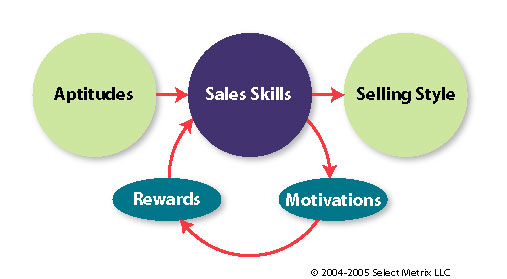|
|
|
Select Metrix
Newsletter |
|
April,
2005 Vol. 1, Issue
4 |
Step 4 - Assess and
Appraise
Last month we
walked through the basics for effectively screening applicants
using a structured phone screen. At this stage in the process,
there is a ranked list of applicants based on their responses to
that phone screen. The applicants that cannot handle the
pressure of a phone call will be identified and eliminated from
consideration. The remaining 3 to 5 candidates handled the call
well and appear to have the right mix of observable traits. Now
they must be objectively measured using validated,
non-discriminatory assessments.
We have
researched and tested many forms of assessments over the past 5
years. Most assessments claim to clearly identify true sales
superstars. However, it has been our experience that no single
assessment can provide an accurate, validated yes/no response
for hiring a sales candidate. What we have found is that a mix
of different assessments blended together provides a far clearer
and more reliable view of the salesperson’s abilities. More
importantly, this information can be overlaid against the
Profile the Sale information for the position. This direct
correlation identifies strengths and gaps in the sales candidate
compared to the sales position.

This graphic
represents the interaction between 5 different assessments that
we use when appraising sales candidates. The results from these
assessments provide a detailed view of the candidate that even
an industrial psychologist would have difficulty discerning.
The interaction between these assessments illustrates aspects of
the salesperson from natural capacities to preferred
communication style.
Aptitudes
– All salespeople have different levels of intrinsic talents, or
aptitudes, to draw from in their development. These aptitudes
are potential growth areas for the salesperson as they refine
their talents into sales skills. One caveat here is that strong
aptitudes are desirable, but certain jobs require a lack
of aptitude in some areas to be effective. An example is a cold
calling-intensive position. Handling Rejection and Self Esteem
are important aptitudes for this position. Strong scores are
most desirable for the role. Conversely, Empathetic Outlook is
important only in that it should be low. Over-empathizing
with a cold call will cause a salesperson to shut down due to
the high frequency of disinterested, even hostile, reactions
from the prospects.
We now come
to the critical center section of the graphic. The area
consisting of Sales Skills, Motivations and Rewards is the
backbone of successful sales hiring. These three aspects, when
properly aligned for your position, provide the engine that
drives optimal sales performance.
Sales Skills
– This assessment is the starting point for all successful sales
hiring. The skills that the salesperson possesses today will
determine how well they fit the position and how quickly they
will ramp to revenue. Successful selling requires the specific
skills used at the proper time to execute a strategy. This
assessment asks candidates to rank responses in 54 different
sales scenarios. This real world approach is the most effective
manner for determining what skills the candidate has today.
This report has 6 specific stages that directly correlate to the
Aptitudes report.
Motivations
– Next to Sales Skills, this is the most important assessment to
use on any sales candidate. The Motivations Report identifies a
candidate’s drivers for their Rewards, Sales Skills and Selling
Style. These Motivations are in play at all times, whether they
are at work, home, vacation, etc. This report accurately
identifies the prime sales motivation that is found in 72% of
the top performing salespeople in any industry. Obviously, we
actively seek this motivation in all sales candidates.
Rewards
– Sales Skills are driven by Motivations and reinforced by
Rewards. Rewards consist of cognitive values – specific job
aspects that are valued by the salesperson. One such Reward is
Status & Recognition. A salesperson who values this Reward will
crave overt recognition of their successes. A salesperson will
excel when their Skills are aligned with their Motivations and
their Rewards are reinforced by the position.
Selling Style
– The most noticeable aspect of any candidate’s composition is
their Selling Style. This assessment identifies their preferred
communication style. Selling Styles are the least important
aspect of a salesperson’s make up, but it is still the best
method for matching salespeople to sales cycles. Understanding
how a salesperson prefers to handle challenges, contacts,
consistency and constraints will lead to placing the right style
to the job’s requirements. One thing is certain, there is no
single Selling Style that fits all sales positions. The best
approach is to Profile the Sale to identify what style is best
suited to the position today.
As you can see, there is much information
to pull together when assessing sales candidates. The
Application in Action
article this month will explain how to identify specific
patterns between the assessments – patterns we call “threads.”
The key in this step is to properly administer objective,
EEOC-compliant assessments to see beyond the exterior of the
salesperson. Last month we mentioned that an unexpected,
pressure-based phone screen will flush most of the schmoozers.
A few highly-refined schmoozers may get past the phone screen,
but they will be exposed by these assessments. After this
step, the wheat will be completely separated from the chaff.
The next step will be the most revealing of entire process.
Next edition
–
The Initial Interview
Click here for the next article -
Assessment Threads |